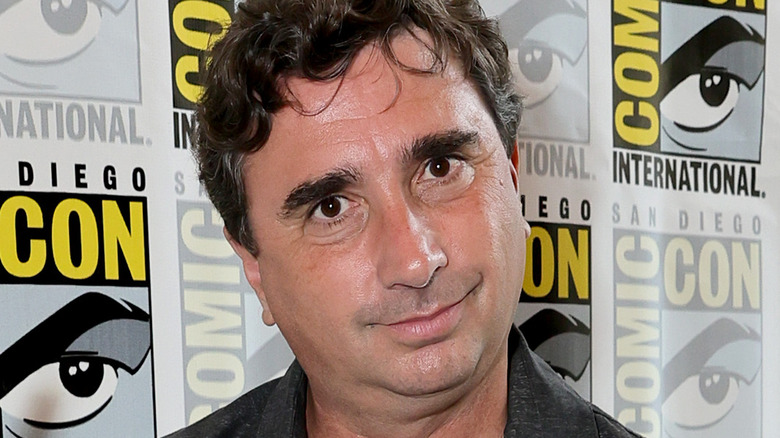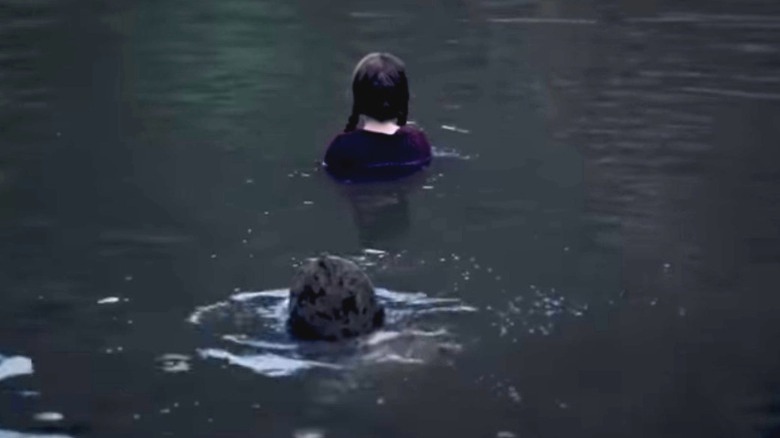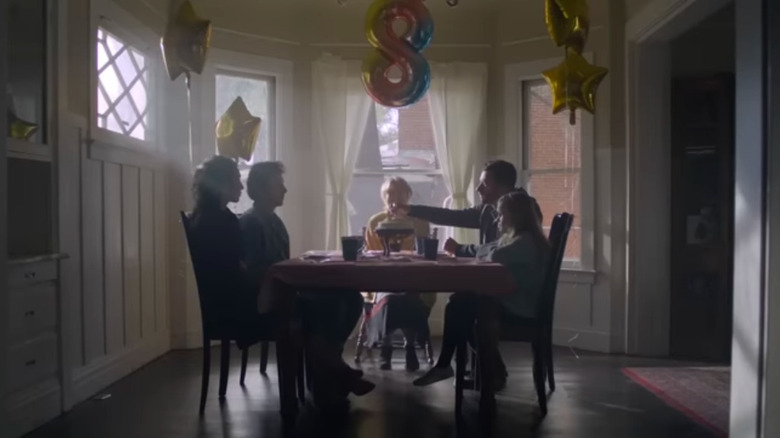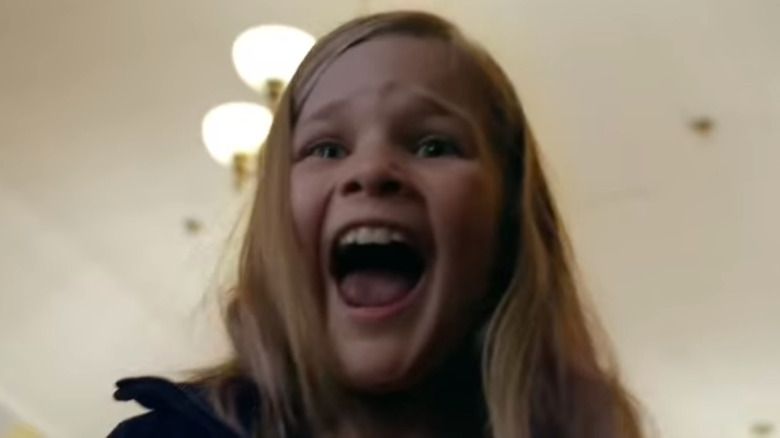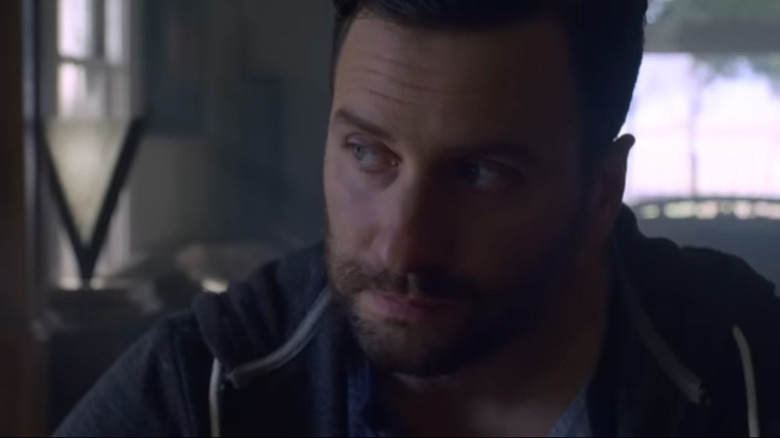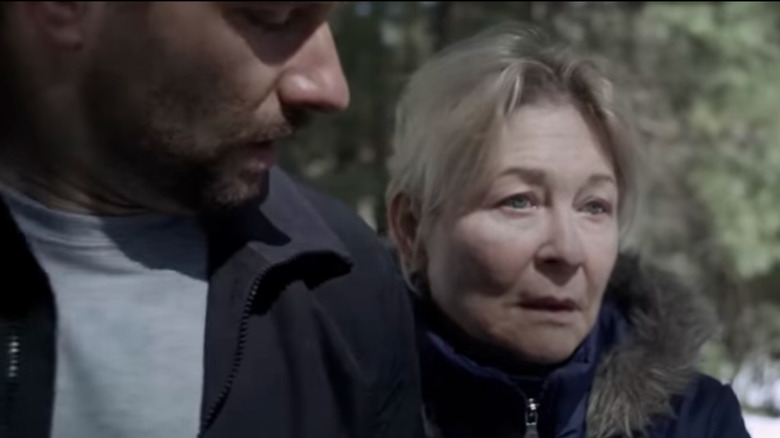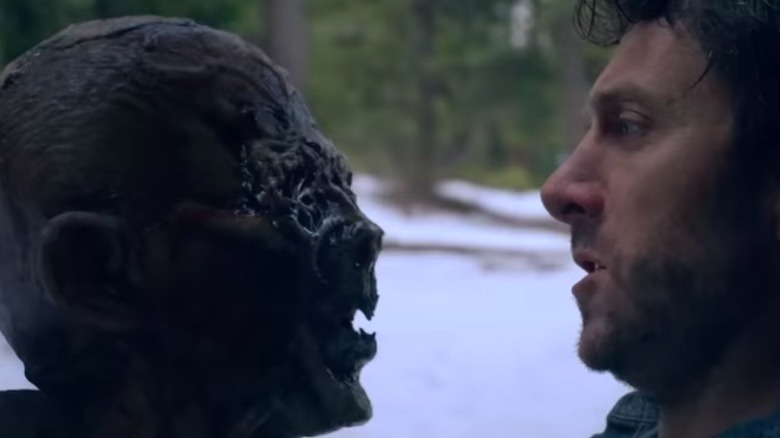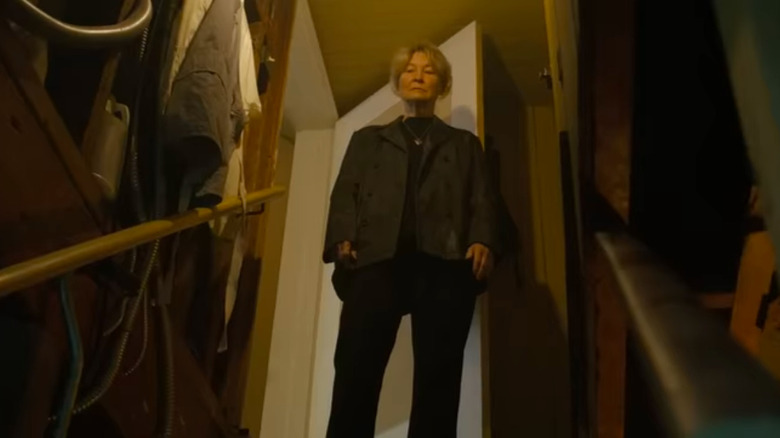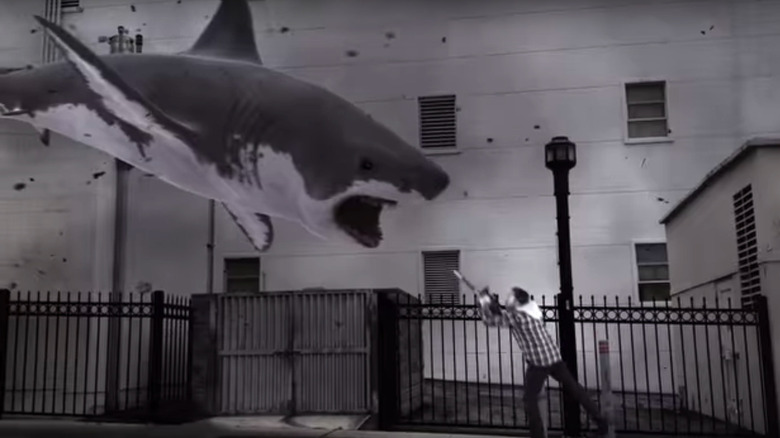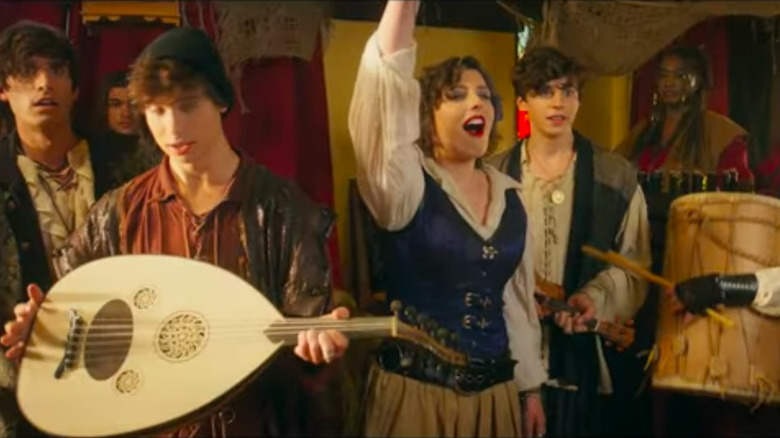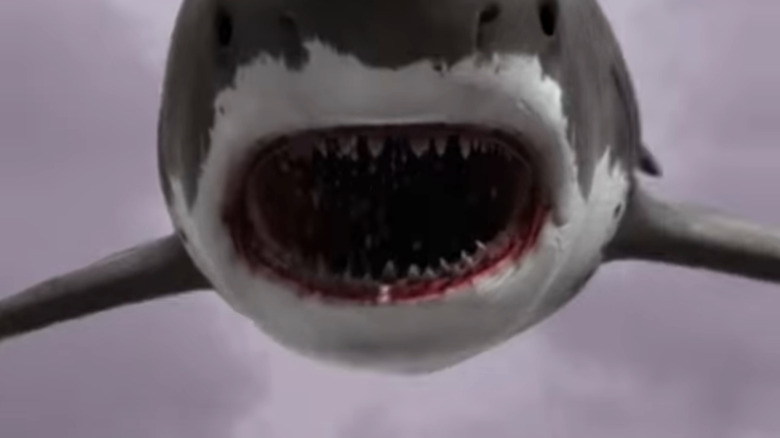Sharknado Director Anthony C. Ferrante On Returning To Horror With The 'Strangely Emotional' Nix - Exclusive Interview
Anthony C. Ferrante is known for directing "Sharknado," a bonkers blast of disaster, horror, and comedy that became a pop-culture juggernaut and spawned five sequels. Yet Ferrante has always loved the horror genre, so for his latest film, "Nix," he chose to take a more grounded approach. The story, which he co-wrote with James Zimbardi, Skyler Caleb, and Woodrow Wilson Hancock III, centers on the grieving Coyle family, mother Donna (Dee Wallace of "E.T."), oldest brother Jack (Zimbardi), and younger brother Lucas (Caleb). After Jack and Lucas' sister (Angelina Karo) and father (Michael DeVorzon) perished under mysterious circumstances during a family camping trip years ago, the remaining family members were left adrift and bereft.
Yet it's not just their loss that's prevented them from moving on from the horror of that day. There's also a mysterious monster that continues to haunt them. Not only is it still out for blood, but it may also be particularly interested in claiming Zoey (Niesha Renee Guilbot), Lucas' young daughter. "Nix" is loaded with monstrous thrills and chills while also telling an emotional tale of family tragedy.
In an exclusive interview with Looper, Ferrante delved into the making of "Nix," including where the concept for the film came from, what he wanted to say with the story, and how the look of the monster was conceived. Ferrante also shared what he appreciated about helming the "Sharknado" movies and what's next for him.
The story's roots in Germanic folklore
The story of "Nix" is rooted in Germanic folklore. What can you tell me about the way that inspired this story?
We started down a path with a different type of mythology, and then it ended up [in] the "Nix" space. I was looking up tons of options. I've done this in the past for other people, like, "Hey, we need to come up with new concepts, so you can scour and start looking." There was this half face in water that I saw. It was for the Nix, the German myth, and I was fascinated by that. I thought, "Wow, that's a great, striking image." Now, the Nix, or the Nokken, or the Nixie, which is all derivative in German folklore, it's a water fairy, which doesn't necessarily lend itself to a horror movie per se, so I took the half face in water and the name and thought, "This is something that we could really hang a movie onto and make our own mythology, and tie it into the things that we were already discussing prior to it." That's the birth of it: this image, this little half face in water I thought was so disturbing. Thinking of a little girl imagining this thing in the water and being terrified of it, I thought it was a good play.
Also, it worked for our story and the arc that we were trying to tell with the film. It had mystery, allowed us to have a creature, but it also allowed us to do something that most horror movies maybe won't try, because they can't or they're not allowed to by the higher-ups. We had the money, and we knew if we could deliver a monster and some effects and some spooky scares, you've got a movie you can sell. Then if we want to do something else on top of that, which is what we did, which was to dig a little deeper, it was a rare opportunity to do something that was unique. These kind of movies don't get made anymore. These are the kind of '70s, '80s horror movies that people took chances on then but no one will take a chance on now. We were fortunate.
Working with the film's co-writers
You wrote the film with three of the film's actors. How did you work together on this story knowing they were going to appear in the movie?
This started life as something else, and then I came aboard and we started working and working on it. I took a first crack at redeveloping this, and we agreed on the treatment, and then I wrote a draft, and then we polished it together. We knew that [James Zimbardi] and [Skyler Caleb] were going to be in the film as brothers. We knew we wanted to shoot in the woods. But the path to how we got to all this other stuff came when we started redeveloping the project. They're great. I had produced a movie they had done a couple years ago, called "Awaken the Shadowman." So when they came to me with this, it was like, "Okay, if we're going to do it, let's go for it. Let's be unhinged and make something that we're happy with, and we hope that people watching it will get something out of it too."
I have to admit, a lot of horror movies, things that people offer me or things that are out in the ether, a lot of stuff is kind of the same thing. That's why I've veered off and done other projects and haven't really dealt in horror, because there's not interesting projects right now. So this was a chance to do something that was different. I call it my first original horror movie since "Boo." That was my very first movie, and I've done some quasi-horror things in the middle, but this is very, very unique.
I wanted to say something. I wanted to get a reaction out of someone more than just being a horror film. And the hat trick I keep telling people that I'm surprised we pulled off is that, for a horror movie, it's strangely emotional. There's some emotional beats that I'm like, "Wow, this actually affects me. I guess we pulled this off somehow."
Most horror movies that come out, at least the stuff I've watched recently, they feel very distant. They're afraid to dig into those emotions. It's just face value at times, or you have these nihilistic characters that are [like], "Millennials don't care about anything," whatever that is. I think ["Nix" is] timeless in the sense that it works [in] any time period because it's not trying to be one thing; it's trying to be its own thing. I like some of those movies that we're talking about; I'm just saying that I don't see people digging that deep sometimes.
Mixing tragedy with horror
The film is scary, but it examines deep family strife and tragedy. What did you want to say through the film?
I've seen, not things where the Nix appears, but I've seen things happen to family and friends, and so have the other [writers], Woodrow, James, and Skyler. I think that part of it is you watch people ... go into these loops where tragedy happens, and then they disconnect from the world. They'll sit in their house, and they won't do anything because they're still grieving. That was the starting-off point for the mom. How does someone get to that point? What is it going to take to get out of that loop? At the core of it is the soul of this little girl. Really, it's Zoey's story, played by Niesha Guilbot.
Everything's happened to the family, and they've already gone down this path, and Jack is trying not to go down the same path, and he has his own loop. He never got to say goodbye to his dad, he never got to tell him he loved him, and he's starting to follow that pattern. And this little girl is experiencing trauma as well. It's all about the sins of the adults being passed on to the kid, and can she not fall to that? We were fortunate with Niesha. She's such an intelligent actress for her age that you see her responding to things and listening and you believe her. That's another thing that anchors the movie that we lucked out with.
Returning to his horror roots
As you said, this is your first horror movie since "Boo," which was almost 20 years ago now. Did it feel good to get back to the genre that you started in?
I did a couple movies in the middle there. I did "Headless Horseman," and I did "Hansel and Gretel," and I did a thriller that had that, but it was fun actually getting to do something that was original and that we were going to do practical effects on. [With] "Sharknado," the first movie, we did have some practical stuff, and then at a certain point, we weren't even in the water, so it was a digital gore-fest. Here, the mandate was practical, tactile, and then there's a tiny, tiny bit of visual effects assist on split screens and some other stuff. But what you see is what we shot, and I think that was part of it. ... Yes, we can have the Nix jumping along walls and doing all this digital stuff. But I think what makes it scary is it's right there, it's tactile, it's right in front of you. Vincent Guastini, who did the makeup effects, did such a phenomenal job on that suit [for the Nix].
I started off wanting to be the horror guy, and I got to do that. I wrote a lot of horror scripts that got made. I directed a few. I grew up loving ... Sam Raimi, Carpenter. But getting to do other things in different genres has made me more aware of other things, so when we got to "Nix," digging deep with the drama on top of it, I was ready for it. That's some of the stuff that I really, really enjoyed doing with this movie.
Casting Dee Wallace
How did you cast Dee Wallace?
She was in my first movie. She was my lucky charm there. I worked with her on "Hansel and Gretel," the other horror movie that I did. When I was writing ["Nix"], I thought, "Dee." I didn't know if we would get her. I didn't know if we could make it work. Talking to the boys, we were like, "Hey, this movie dies or succeeds based on who we cast in this role. We need somebody that can nail it." So we made it happen, did a little begging: "Can you please do this for us?" She loved the role and she committed to it. She committed to wanting to go to those dark places. ... It was a great collaboration. Since then, she's been in two other films of mine. She's my good luck charm, and I love working with her.
Conceiving Nix's monster
The monster has an amazing look. How did you go about conceiving it?
We knew we needed a good creature. A buddy of mine, Jacob Hair, actually is a director over at "Rick and Morty," and ... it was actually the two of us that [came up with] the name "Sharknado" before I ended up directing that movie, so he's a really good conceptual guy. I go, "Can you do me a favor? Can you help me get the ideas down on paper?" So we spent an afternoon talking about the creature and how to make it a little different and the web dyes and all that stuff. The movie started off, [as] I told you, with the half face in water, so we had that as a starting-off point. Then we sent it over to Vincent Guastini. His guy then made a little adjustment.
A lot of times in these horror movies nowadays, everybody wants to lean on the visual effects, and I've certainly done the visual effects. But in this case, it needed to be practical because if you don't, then you're taken out of the movie. Knowing that thing is in the hallway ... I love the idea that it's standing in the hallway. And the character Liz is there, and it's just a shadow, and that makes it disturbing.
It was not an easy movie to make because when we decided to go to the woods, the night before, we were staying at the cabins on that property. It was in Redding in Shingle Town in Northern California. It snowed the night before, a ton of snow, and we're like, "Now I guess there's snow in the movie." Having done a bunch of "Sharknados," we always said, "Well, whatever the weather is, it's 'Sharknado' weather, so if it changes, that's fine." So I said, "Let's get a game plan." We lost three or four hours in the morning try[ing] to get our bearings, and we made the snow part of the movie, which also added [something] to the look of the movie that we probably wouldn't have gotten otherwise. Shooting a creature suit in the snow [in] freezing temperatures, when we weren't planning to have snow and we were in the middle of nowhere, certainly posed some challenges. But we got through it, and I think the movie's better for it.
Applying lessons from Sharknado to Nix
As you mentioned, you directed the "Sharknado" movies. Was there anything you learned on "Sharknado" that you found you could apply to "Nix"?
I couldn't have done "Sharknado" 6 without "Sharknado" 1. And I couldn't have done "Nix" without every movie that came before it. [I had] the understanding, "Okay, things are falling apart. You have snow. How do you deal with it?" Being able to stretch the dollar like we did on "Sharknado" certainly comes in handy with a film like "Nix." [I understood] where we need[ed] to go, because we tried to shoot it in Los Angeles, [and] we couldn't afford it.
It was also in the middle of COVID, so [that] was a problem. My hometown is Antioch in Northern California. I'd shot a film previously there called "Forgotten Evil," and I know that they're very supportive, so we asked them if we could film there and they opened their arms again to us and let us film in the town. The [Coyle] house was actually a former house turned into an art gallery that was dormant during COVID. So we brought the furniture in, and that was our base camp, and that was our house.
The theater El Campanil, that's where I used to see movies when I was growing up. I filmed my very first short film at that theater. In the basement area where Mom is toward the end, that's all the Campanil, so I knew these things existed. We shot at the high school I went to, Antioch High School. The Antioch Heritage Museum, we shot there as well. There was a lot of goodwill and a lot of support, [and] I feel eternally grateful they let us do this. It added to the film. That's being resourceful: "How can we do this with our budget and get a good look?" So "Sharknado" taught me how to push the dollar beyond its limit and still come up with something that looks great.
What kept him coming back to Sharknado
You did a lot of "Sharknado" films. What did you enjoy about directing those films that kept you coming back for sequel after sequel?
Part of it was I started it, so there's that proprietary thing, and they at least welcome me back to do them. But each movie was different. I know ... a lot of people think they're [all] the same movie, but if you actually went in and dug into each one of them, there's an ongoing arc for the six movies of what we're trying to do.
The first movie was a Los Angeles film. The second movie is in that "Evil Dead" space, where you get more money to do the second movie, so you remake the first movie and make it better. I feel like the second one in New York was similar to the first movie but even crazier and wackier. We knew what we were doing; we knew what it was at that point. [The] third movie was a White House disaster, "White House Down" movie with sharks, an amusement park disaster movie, and a space movie. We crammed three movies into one.
[The] fourth one was a science fiction movie. [The] fifth one was a global film — we traveled to all these countries and did a global adventure. And then the sixth one was time travel. So we kept it interesting. I love these characters, I love that franchise, and I love the fact that I was a filmmaker that started it and ended it. I don't think there's any filmmaker that's done six movies in a franchise and also ended it, from beginning to end, so that was the badge of honor.
Coming up next
What's coming up for you next?
A lot of different things. I did, earlier this year, a pirate musical called "Time Pirates." There was this group called SM6. They're a group of six siblings. They do this rock music. They're pretty popular on social media. This company had wanted to do a movie, like "Hard Day's Night" or "Monkees," with them. They approached me because I do music. I love music, and I've written a lot of songs for these horror movies. The "Nothing" song at the end of "Nix" I wrote with Robbie, my writing partner. That's our band.
The chance to do something that was different, and they had all their songs, it sounded like it'd be a great opportunity, so we ended up shooting this thing. It's a pirate musical time travel movie. It has animation; it has musical numbers choreographed by Richie Jackson, who works with Lady Gaga. It has a little bit of "Monty Python." It's very non sequitur, very off the cuff, very strange and weird, and I'm really proud of it. You can find that on Tubi. That just came out two weeks ago: "Time Pirates."
Last fall, I did two back-to-back Westerns. I do development at the company that I work for, and they were working on two "Butch Cassidy" films that were going to be done back to back. I cracked the code for the second movie and became really enamored [with] the universe that the writer, Jeff Meda, created, so I lobbied to direct them. So we shot back-to-back "Butch Cassidy" movies last fall. It's "Butch Cassidy and the Wild Bunch," which I think comes out in December, and then early next year, "Butch Versus Sundance." They're not horror movies; they're Westerns. Bruce Dern is in it, Dee Wallace is in it, and Jeffrey Combs plays Charlie Siringo, Pinkerton detective. He's the heavy in the movie, and he is phenomenal.
Then I have a horror movie I'm going to be directing later in the fall, so I'm a busy bee.
A director of many genres
The thing is that with "Sharknado," I can only do a movie a year, with maybe a commercial or something, because it was so exhausting. But you get opportunities with this material, and it's like, "Well, it's a pirate musical. When am I going to get to do that?" And you go, "Yes," because why not? One of the beauties of "Sharknado" was that it allowed people to see me in a different light, to be able to do different things. So I've had the ability to do dramas and thrillers and comedies.
I will never forsake the horror genre. That's my roots. I love the fact that I am perceived as a director [of many genres] now. I direct different things and that keeps it interesting. Just like you asked me about "Sharknado," every "Sharknado" movie, that's what kept it interesting. To go off and try to do a Western, which, to be honest, I never thought I'd be doing a Western. I had an idea after "Sharknado" 6 because we did a little mini-Western segment in there. I had this kernel of an idea that I was thinking I wanted to do, but this was the perfect opportunity because I never thought someone would hire me to do a Western, let alone two of them. We need to make those successful because now I have four other movies I want to tell in that universe.
This interview has been edited for length and clarity.
"Nix" is available on all major digital platforms.
